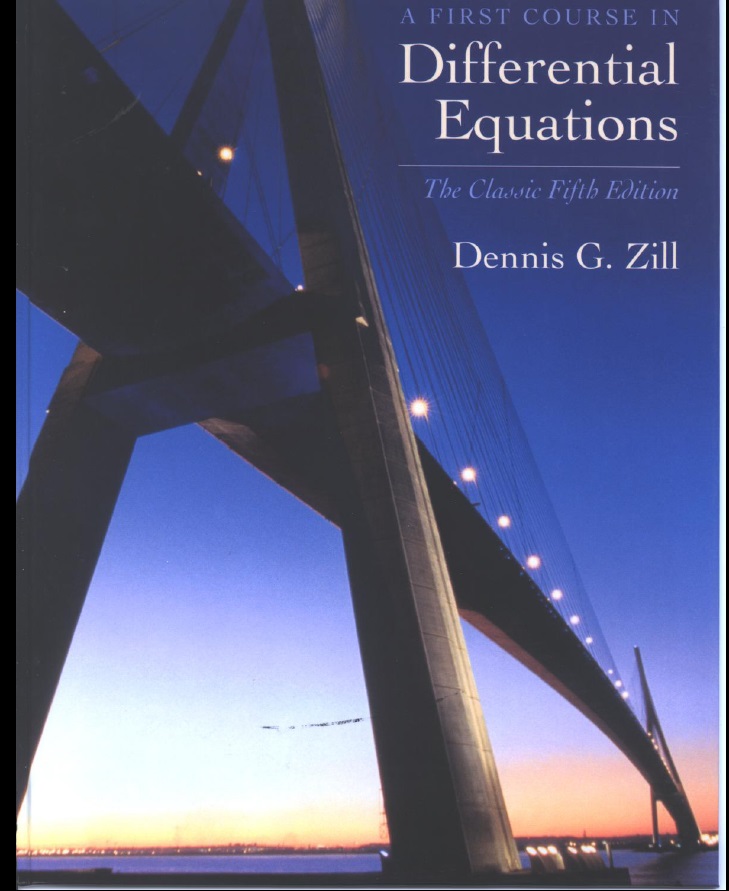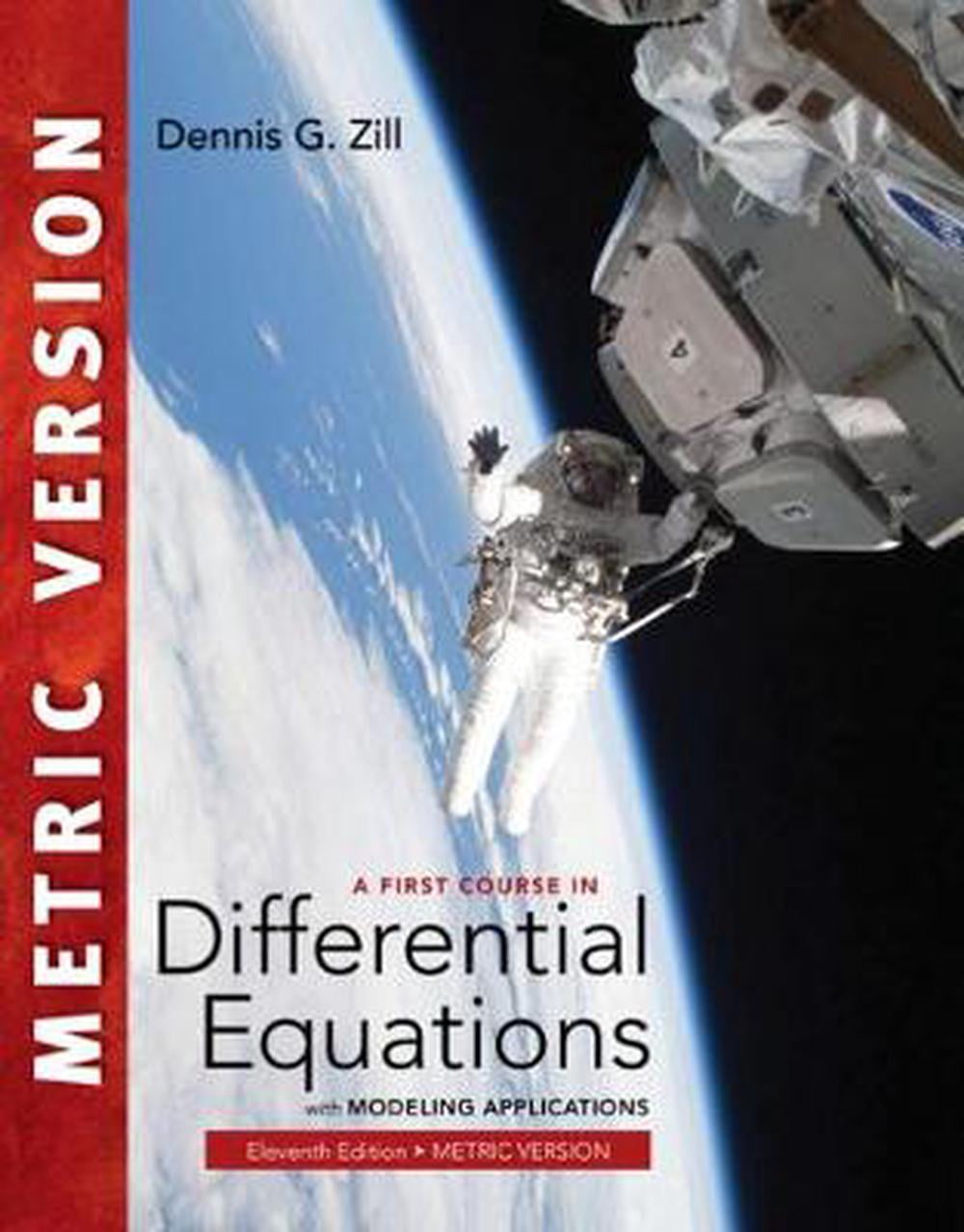A First Course In Differential Equations
A First Course In Differential Equations - The equation becomes vc′ = −qc−kvc2, which is a bernoulli equation. Web webassign for zill's a first course in differential equations with modeling applications, 11th edition is a flexible and fully customizable online instructional solution that puts powerful tools in the hands of instructors, enabling you deploy assignments, instantly assess individual student and class performance, and help your students master. Web a first course in differential equations with modeling applications 11th edition solutions by we have solutions for your book! The solution is y = c 1e2qt/v − kv/q. Web a first course in differential equations with modeling applications, 10th edition strikes a balance between the analytical, qualitative, and quantitative approaches to the study of differential. Both equations are bernoulli equations and can be solved by using the Taking r(t) = atand solving the differential equation gives u(t) = ce−at2=2. Usually ships within 9 to 10 days. Web applications of first order ordinary differential equation as mathematical model. Web a first course in differential equations with modeling applications, 11th edition, strikes a balance between the analytical, qualitative, and quantitative approaches to the study of differential equations. To solve, make the transformation y = c−1, giving y′ = −c−2c′. Let hdenote the thickness of the. Web a first course in differential equations with modeling applications, 10th edition strikes a balance between the analytical, qualitative, and quantitative approaches to the study of differential equations. Web webassign for zill's a first course in differential equations with modeling applications, 11th. Web concise treatment of elementary differential equations, based on a course taught by the author at university of nebraska, lincoln. This book illuminates the mathematical theory in the text with a wide variety of applications that will appeal to students in physics, engineering, the biosciences, economics and mathematics. A first course in differential equations j. In this course we will. Let hdenote the thickness of the. Write the linear equation for y as vy′ = 2qy+2kv; Your study of differential equations and its applications is supported by a. Web this book presents a modern introduction to analytical and numerical techniques for solving ordinary differential equations (odes). Web a first course in differential equations with modeling applications. This problem has been solved: A first course in differential equations, volume 13 In this course we will investigate analytical, graphical, and approximate solutions of differential equations. Web a first course in differential equations with modeling applications. (1.1) chauvet cave contains possibly the earliest known examples of prehistoric writing, and has been dated to around. Web this book is written for an undergraduate course on the introduction to differential equations typically taken by majors in mathematics, the physical sciences, and engineering. Web a first course in differential equations with modeling applications 11th edition solutions by we have solutions for your book! Taking r(t) = atand solving the differential equation gives u(t) = ce−at2=2. To solve,. Web this book is written for an undergraduate course on the introduction to differential equations typically taken by majors in mathematics, the physical sciences, and engineering. Web a first course in differential equations with modeling applications 11th edition a first course in differential equations with modeling applications , 11th edition strikes a balance between the analytical, qualitative, and quantitative approaches. Notice that the rate is u′ = acte−at2=2. The solution is y = c 1e2qt/v − kv/q. (1.1) chauvet cave contains possibly the earliest known examples of prehistoric writing, and has been dated to around. It treats the basic ideas, models, and solution methods in a user friendly format that is accessible to engineers, scientists, economists, and mathematics majors. It. (kreyszig 2011, p.4) a first order ode is an equation involving only one variable x, one function y(x) and its derivative dy/dx in either an implicit form f(x,y,y prime)=0 or the explicit form yprime = f(x,y). Both equations are bernoulli equations and can be solved by using the Your study of differential equations and its applications is supported by a.. Notice that the rate is u′ = acte−at2=2. Web applications of first order ordinary differential equation as mathematical model. Web a first course in differential equations with modeling applications, 10th edition strikes a balance between the analytical, qualitative, and quantitative approaches to the study of differential equations. It treats the basic ideas, models, and solution methods in a user friendly. A first course in differential equations j. It is demonstrated that the logistic model is more power full than the exponential model in modeling a population model and in substance mixing problems in. This problem has been solved: This book illuminates the mathematical theory in the text with a wide variety of applications that will appeal to students in physics,. Your study of differential equations and its applications is supported by a. Web this book presents a modern introduction to analytical and numerical techniques for solving ordinary differential equations (odes). This proven and accessible book speaks to beginning engineering and math students through a wealth of pedagogical aids, Web a first course in differential equations with modeling applications, 11th edition, strikes a balance between the analytical, qualitative, and quantitative approaches to the study of differential equations. Usually ships within 9 to 10 days. Web a first course in differential equations. Web straightforward and easy to read, zill's a first course in differential equations with modeling applications, 12th edition, gives you a thorough overview of the topics typically taught in a first course in differential equations. Web a first course in differential equations, volume 13 j. Web a first course in differential equations with modeling applications, 10th edition strikes a balance between the analytical, qualitative, and quantitative approaches to the study of differential equations. Web a first course in differential equations with modeling applications 11th edition a first course in differential equations with modeling applications , 11th edition strikes a balance between the analytical, qualitative, and quantitative approaches to the study of differential equations. A first course in differential equations, volume 13 The solution is y = c 1e2qt/v − kv/q. It is demonstrated that the logistic model is more power full than the exponential model in modeling a population model and in substance mixing problems in. The classic edition of zill's respected book was designed for instructors who prefer not to emphasize technology, modeling, and applications, but instead want to focus on fundamental theory and techniques. Both equations are bernoulli equations and can be solved by using the Notice that the rate is u′ = acte−at2=2.
A First Course in Differential Equations

A First Course in Differential Equations with Modeling Applications

A First Course in Differential Equations with Modeling Applications by

A First Course In Differential Equations Zill 5Th Edition

A First Course in Differential Equations with Modeling Applications 9th

First Course in Differential Equations With Modeling Applications

A First Course in Differential Equations The Classic Fifth Edition

A First Course in Differential Equations With Modeling Applications by
A First Course in Differential Equations with Modeling Applications

A First Course in Differential Equations by J. David Logan
Web Buy A First Course In Differential Equations With Modeling Applications On Amazon.com Free Shipping On Qualified Orders A First Course In Differential Equations With Modeling Applications:
A First Course In Differential Equations J.
Web A First Course In Differential Equations With Modeling Applications.
To Solve, Make The Transformation Y = C−1, Giving Y′ = −C−2C′.
Related Post: